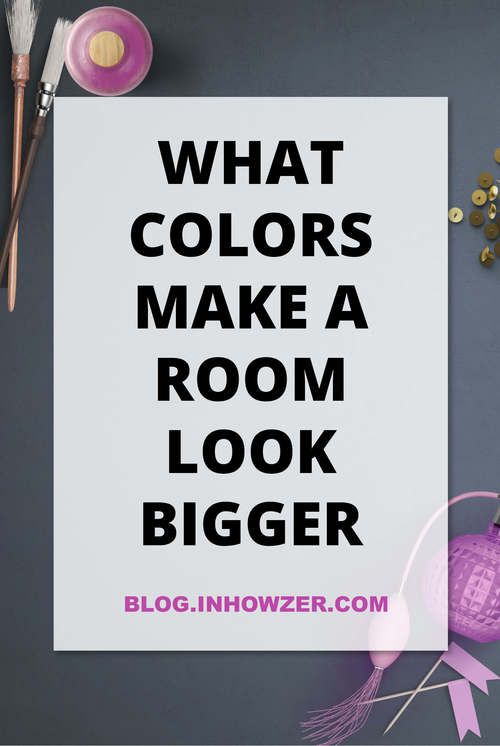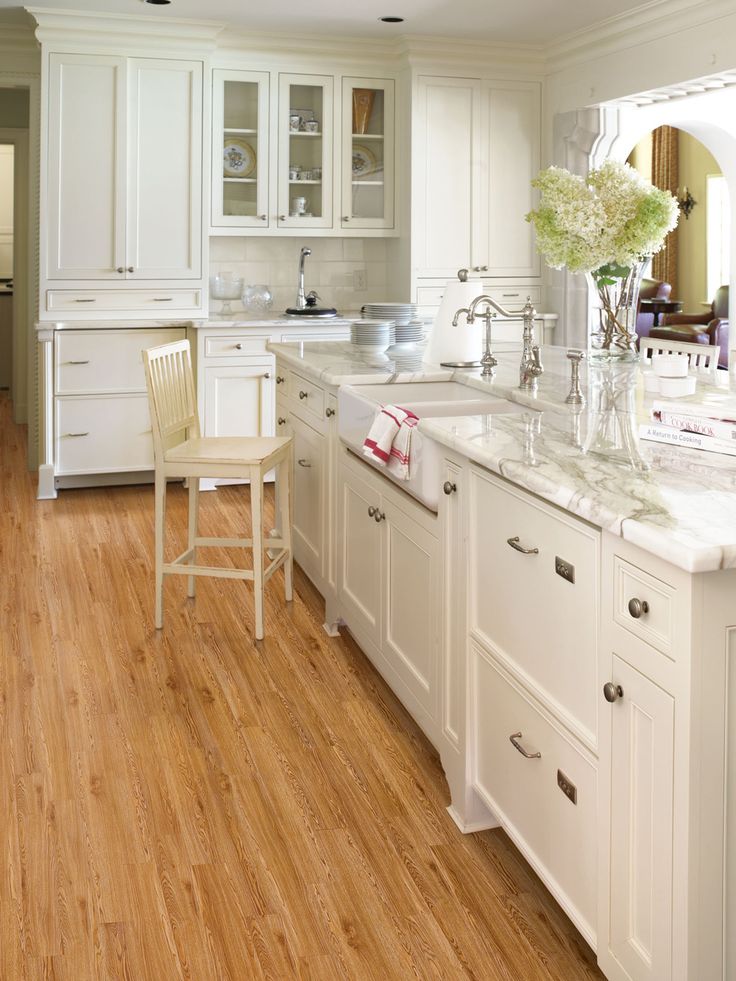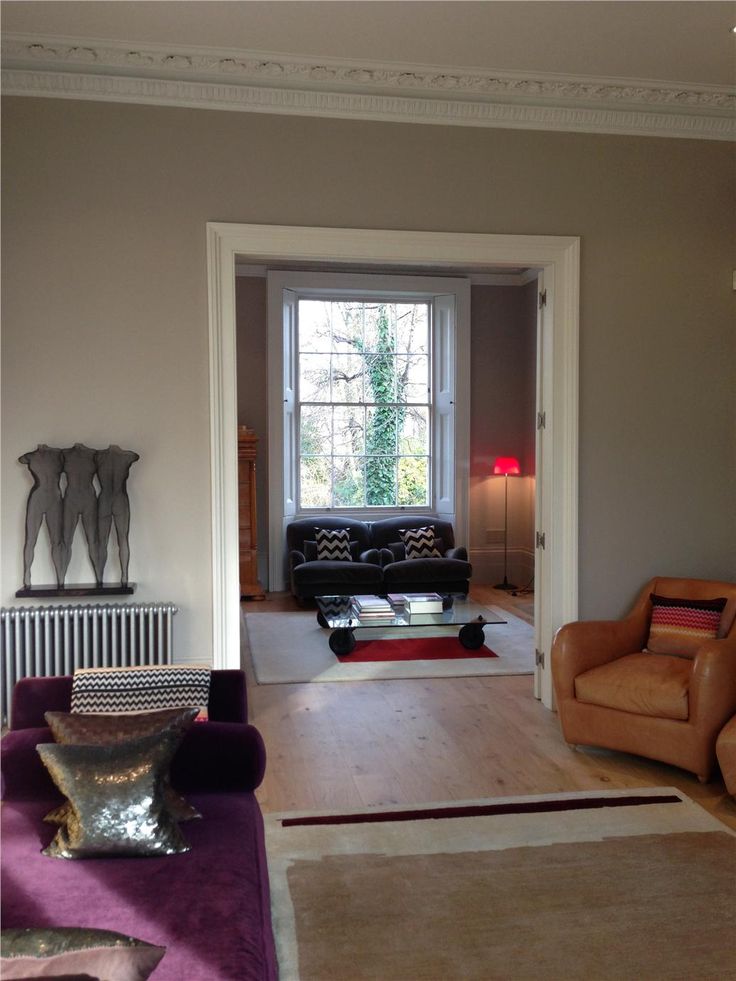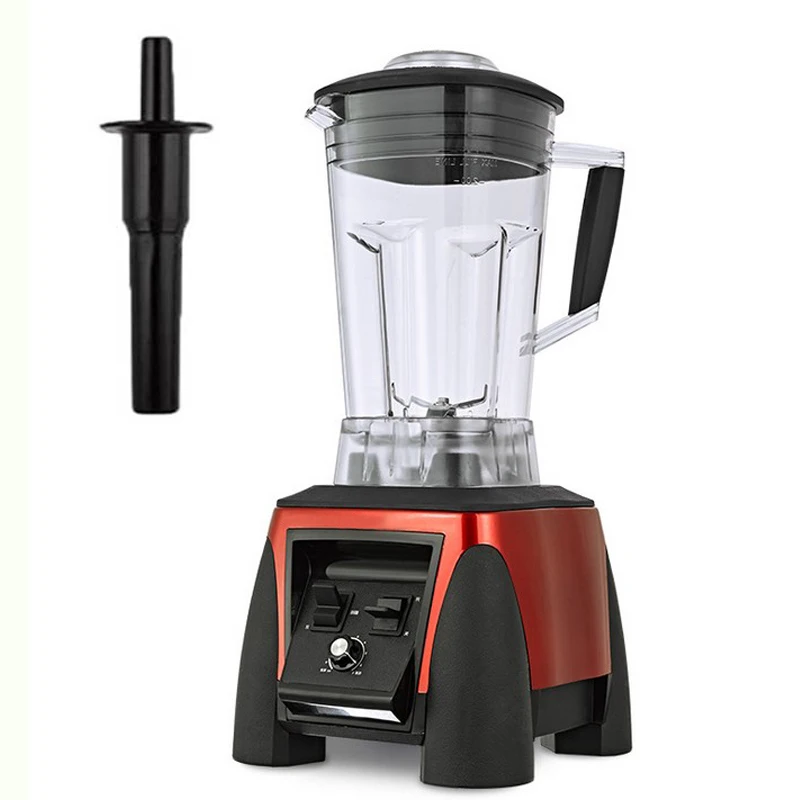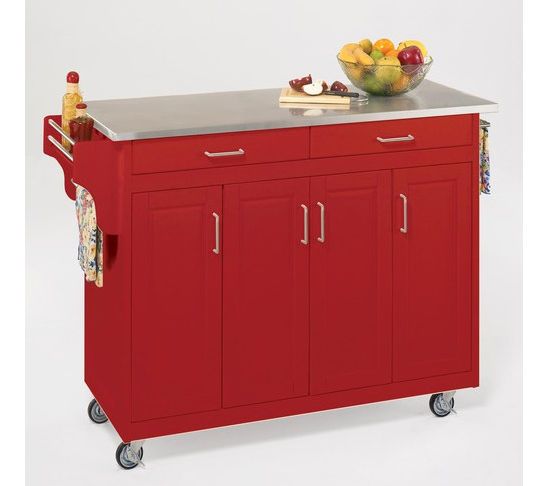Colours that make a room look bigger
10 Color Options That Will Make Small Rooms Look Bigger
Your home is where you come back to relax, connect, and just be yourself. Personal touches, beautiful décor, and light furnishing can absolutely change the way you look at a room. Despite these extra nuances, your room may still feel small and even claustrophobic. A great way to make a room look bigger and feel more open is with different paint options.
Color has the unique ability to transform any room and with the right selection, you can set the perfect tone for your space. Here are some colors that make a small room feel much more open.
1. Dark Blue
Dark blue has the transformative power to make a statement. Small rooms are often the best place to make an impact. Richer tones on one wall with lighter, bright tones open the space in the room. It feels moody and bold which distracts from the lack of space.
2. Earthly Ochre
Earthly Ochre is a deep, warm color that creates a calm environment. The light tan colors with sunlight streaming through open windows increase the dimensions of the room. It makes the space look more inviting simply by indulging in warmer tones that please the eye.
3. Off-White
Off-white paint is such a simple, clean color, making it easier to work with. The soft color makes the space look more inviting and open. The room also begins to feel larger if you contrast it with natural greenery and vibrant colors. It works well in spaces where you generally want to relax or have fun like living rooms, since they look more inviting with an off-white color scheme.
4. Clean White
A crispy white has the perfect clean feel to it, emitting a sense of calm throughout the room. White also has the right level of softness to be considered cozy. This is especially true if you pair it with beautiful wooden flooring and a bright décor. Mix in some other colors in the furnishing and plants to make the whole room feel more alive.
5.
 Dark Grey
Dark GreyA darker gray tone for small rooms looks minimalistic and modern. Regardless of whether you have casual or fancy furnishings, you will be able to make the room look crisp and clean. This is because dark grey is a great twist against the more traditional white or simple beige colors. The dark gray will definitely make your room look elegant and sophisticated.
6. Pale Blues
Pale blue has the gentle quality of making a space feel open and light. It looks beautiful when the light filters in through sheer curtains and produces a soothing quality in the room. When paired with other light colors, like pale pink and white, it sets a calming tone to any room. This is one color that can definitely make a room feel bigger. It works best for internal rooms like bedrooms or baby rooms.
7. Sea Green
Sea Green is a really popular color since it has a very minimalistic vibe to it. It pairs really well with wooden furniture and décor since the whole room looks earthy. This sets a nice mood to the room and can be soothing for just anyone. If you decorate with other earthy tones and textures, you will notice how the color can freshen up the room in no time at all.
This sets a nice mood to the room and can be soothing for just anyone. If you decorate with other earthy tones and textures, you will notice how the color can freshen up the room in no time at all.
8. Light Green
Light green is an amazing vibrant color that pairs well with white to create a more open. It can add a really nice modern touch to a room, making the whole room look more inviting and calmer. This color works great for living rooms since this is the main space for your guests to relax.
9. Charcoal Black
If you don’t have a source of natural light in a room, a dark charcoal black can make the room feel more intimate rather than stuffy if you use it as a complementary color to a lighter main color scheme. Pair it with more modern, sophisticated light colors, such as light blues, purples, white, and lighter greens, and you’ll get a grand open space.
10. Taupe
A taupe wall is a brilliant solution for small rooms, as it falls in the lighter end of the color scheme and offers a more colorful solution to tans and whites (two color options most used when trying to make a small room appear bigger). Taupe is a light, relaxing color that improves the mood of a space while adding a splash of color.
Taupe is a light, relaxing color that improves the mood of a space while adding a splash of color.
Small rooms are no match for a carefully chosen color palette and a minimalistic design scheme, but if you find yourself at a loss when putting together the perfect collection of colors and textures for your space, just contact Romanza Interior Design. Our award-winning interior designers provide an integrated approach blending innovative interior design with superior service to capture the spirit of each homeowner and deliver a unique home design that reflects your tastes, lifestyle, and personality.
6 Paint Colors That Make a Room Look Bigger
Graphic by Cristina Cianci
Small rooms can be tricky to decorate. Beyond the simple issue of having to triple-measure furniture for size and crafting the best layout for your space, paint color can actually have a huge impact on how big or small your space feels—and this decision goes beyond pure color choices. Paint a room in a color that's on the darker side, and you may make a light-filled room feel smaller.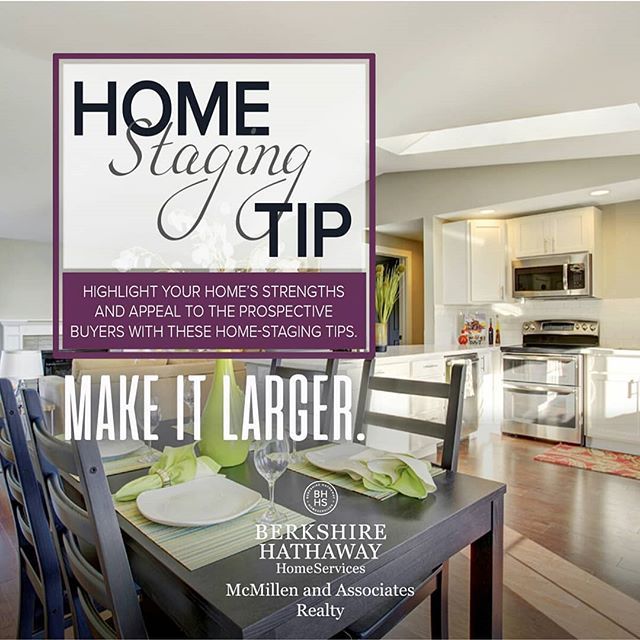 But use a stark white paint color in a north-facing room, and you may end up with a classic "white box syndrome"—a sad white room with no personality.
But use a stark white paint color in a north-facing room, and you may end up with a classic "white box syndrome"—a sad white room with no personality.
There are a ton of variants that dictate which color you should choose for your small room, like the direction that the windows of your space are facing. Dark colors work best in north-facing rooms, while light ones will look better in bright south-facing spaces. Sunset hues can do wonders to a west-facing room, especially at dusk.
Ahead, find the top 6 paint colors that will make any room—of any size—look instantly larger.
01 of 06
Courtesy of ASH NYCNaturally, white is an obvious choice for making a room feel bigger. It's no secret that light colors make a room look larger, especially if the space is bathed in natural light. Eggshell or satin finishes will help reflect the light, creating the appearance of even more space.
What's more, it works no matter your aesthetic or room type. Whether it's a modern kitchen, deco living room, or country-inspired bedroom, white is a great palette to begin your decor process.
Use this color in: South-facing rooms
02 of 06
Courtesy of Tali RothConversely to white, in a room with little to no natural light, white may not be the way to go. With no light bouncing off the walls, the color could have the opposite effect on your space. Lean into the lack of sun, though, and go fully into the dark realm.
Instead of white, a dark hue like charcoal or black will give the space an intimate feel while simultaneously giving it an appearance of grandeur—especially if the ceiling and trim are also painted in the same hue.
Use this color in: North-facing rooms
03 of 06
Becca Interiors
For those who aren't willing to go entirely white but still want a light neutral paint color for their room, a light taupe or greige can make a space feel large and elegant. It is still bright enough to allow the light to bounce off from one wall to another, but adds a touch of warmth that a true bright white doesn't have.
This rich tone has the potential to make a room look expensive, so use it in a space with little architectural detailing to give it stature. When using this color, it helps to keep other furnishings white in the room to help give the space a light and airy feel.
Use this color in: Rooms with no architectural details
04 of 06
Courtesy of Fantastic FrankA soft shade of blush pink can brighten up a small room and make it feel cheery and light—and it looks wonderful at sunset hour. This hue works best in a room with more natural light and is well complemented with light warm neutral tones like beige, sand, and ivory. Paint the ceiling in the same hue for an enveloping feel.
Don't be fooled by pink acting as an ultimate feminine tone, either (though it can!). The pale blush is also a great compliment to more masculine woods, modern metals, and luxe velvet or leather furniture as well.
Use this color in: West-facing rooms
05 of 06
KatarzynaBialasiewicz / Getty Images
In rooms with little bit of natural light, a deep navy hue can create an impression of depth and make a space feel dramatic and stately. If you want that romantic and cozy feel that a black room would give you, but not willing to take the plunge into the absence of color, navy is the way to go.
If you want that romantic and cozy feel that a black room would give you, but not willing to take the plunge into the absence of color, navy is the way to go.
When painting your walls in a navy color, it also helps to keep large furniture like sofas in the same hue to blur the lines between the edges of the room and making it feel larger. This also makes it a great choice for rooms with cabinetry like kitchens and libraries. Pro tip? The monochromatic styling works equally well, no matter what color you're dealing with.
Use this color in: Kitchens and libraries with little natural light
06 of 06
Courtesy of Brady Tolbert A great alternative to a white paint color is a light cool gray, which can feel fresh and bright without the starkness of pure white. Cool colors feel fresher and brighter than warm ones, so it helps visually create the appearance of more space. Use this color in a room with moderate amounts of light to give the space a cozy but expansive feel.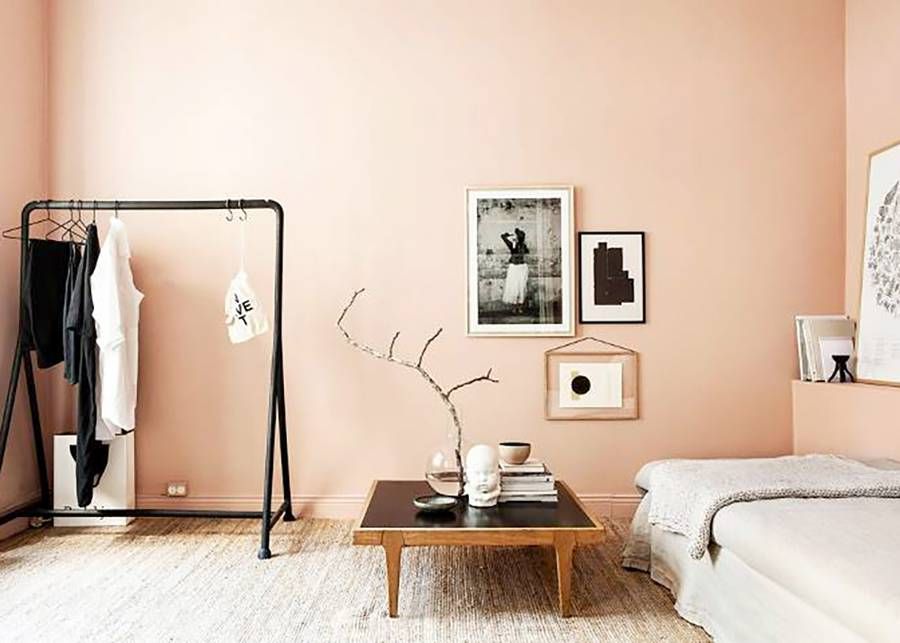
A light grey brings the crisp and bright quality that a bright white does, allowing light to bounce off the walls, while it also keeps the room remaining cool, as opposed to the warmth that a taupe would infuse.
Use this color in: An east or west-facing room
Here's How to Make a Narrow Room Look Wider
How to visually enlarge a room with color
Contents
- 1 What color to use to make the room appear bigger?
- 2 How to enlarge a room with paints? About equipment and accessories
- 3 How to paint a small room to add character?
- 4 Small Room Techniques
- 5 Small Room Design with Lots of Storage
Small rooms have their own charm because they are very cozy. However, there is always a desire to visually enlarge it. There are many ways to make a small room look bigger and more spacious. The main role here will certainly be played by the colors of the walls, but contrary to appearances, white is not the only color that can be allowed.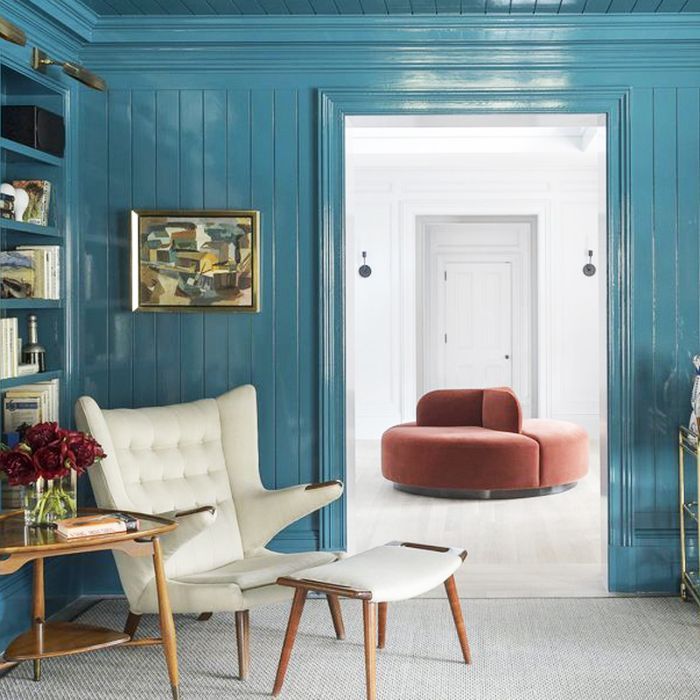 Painting a small room can also include creating an original, surprising interior - using well-chosen colors. nine0003
Painting a small room can also include creating an original, surprising interior - using well-chosen colors. nine0003
What color to use to make the room look bigger?
Although this is not a new idea, it should be noted here: light colors of the walls optically increase the interior, while dark colors reduce it. However, a skillful combination of light and dark colors can give a very good effect in the form of an optical enlargement of a room. Colors that enhance a room are undoubtedly white, light gray and blue.
It is also worth remembering that cold colors optically move walls away, while warm colors bring them closer together. Cool tones reflect light and warm tones absorb it. This also applies to paint finishes: matte absorbs light, while slightly shiny (satin) reflects it. nine0025 When planning an optical enlargement of a small room, white is the most commonly used color. And while white was once just white, there are now a range of shades to choose from.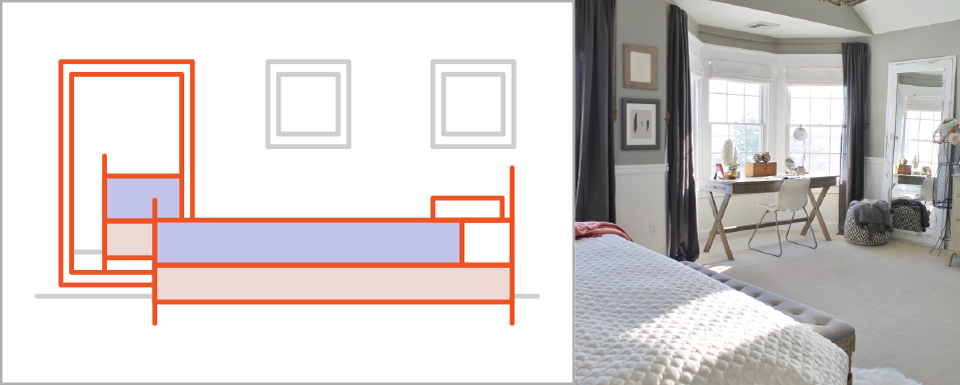 The most famous (although not so often used) is snow-white. For more effect, you can combine it with a shade of another color, such as pink, vanilla or pastel blue. Also pure white looks great with a brighter color on the wall next to it or on furniture. In turn, the so-called off-white is a good neighborhood with neutral colors or pastels. nine0003
The most famous (although not so often used) is snow-white. For more effect, you can combine it with a shade of another color, such as pink, vanilla or pastel blue. Also pure white looks great with a brighter color on the wall next to it or on furniture. In turn, the so-called off-white is a good neighborhood with neutral colors or pastels. nine0003
How to enlarge a room with paints? About equipment and accessories
Playing, deceiving the eye and trying to visually enlarge the room, you should not only choose the right color for the walls, but also the furniture and accessories. Bright furniture, especially beige, light gray and white, will fit perfectly into a small room.
A good way to visually enlarge a small room is to hang a large mirror in it. The best effect can be achieved if the mirror is frameless. The mirror should reflect something that will be interesting to look at - a beautiful bedspread, a favorite picture or a large green flower. nine0003
Photo wallpaper can also be used to create the illusion of space.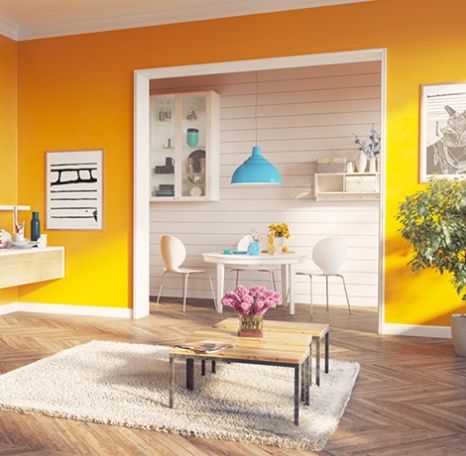 It can be, for example, a path leading into the middle of the jungle, a street from which a Greek city is visible, or a suspension bridge through the trees.
It can be, for example, a path leading into the middle of the jungle, a street from which a Greek city is visible, or a suspension bridge through the trees.
In a small room, it is better to refrain from hanging heavy curtains and curtains. Instead, you should install blinds or light white delicate curtains.
How to paint a small room to add character to it?
When furnishing a small room, it is worth considering not only its optical magnification, but also its uniqueness and originality. Several methods can be used here. Choose at least two paint colors for the room, such as from the same color palette but in a different shade: mint and light green, as well as heavily bleached pink and very light lilac. nine0003
Painting one wall a richer, darker color also gives a fantastic effect. It can be a wall near a desk or behind a TV. It is better not to paint all the walls in a dark color. It is also worth remembering that the floor and ceiling remain light. The only exception is apartments in apartment buildings, where the height of the rooms is 4-5 meters.
A long and narrow room can not only be enlarged optically, but its proportions can also be evened out. In this case, longer walls are visually removed by painting them with cold-colored paint, and shorter ones are brought closer by painting them with warm-colored paint. Another equally effective way is to paint the narrower wall a rich color that contrasts with the rest of the walls. Such a procedure will make it seem further than it actually is. nine0003
Techniques for furnishing a small room
Choosing the right color for walls, furniture and accessories is not the only way to optically enlarge a small room. Sometimes quite satisfactory results can be achieved with little cost and effort. For example, a ceiling can be optically elevated by painting it a pure satin white, and white stripe can be minimized (or eliminated) at the top of painted walls. On the other hand, the wider the strip, the greater the effect of dividing the walls. Here it is worth deciding whether you need to optically enlarge the ceiling or visually expand the walls.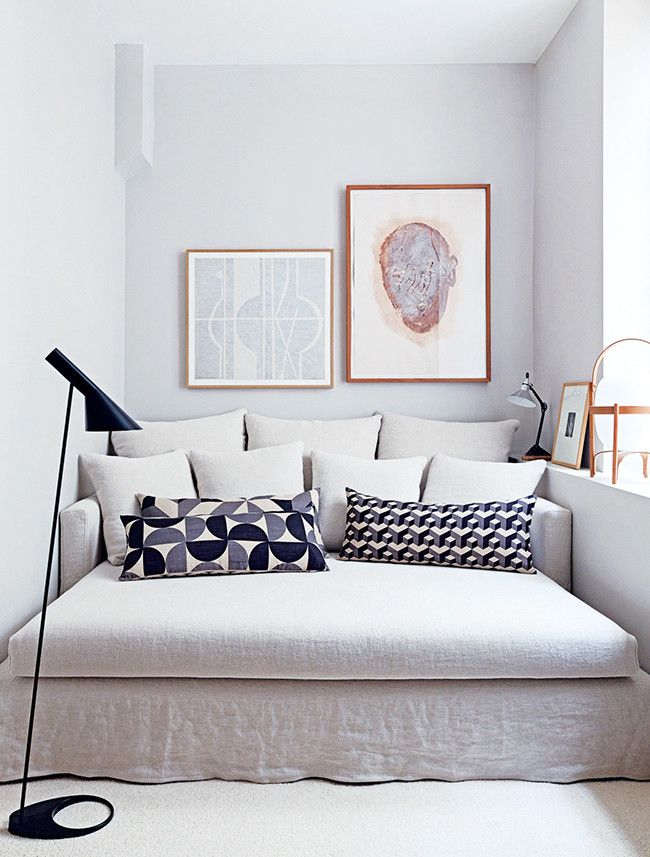 nine0003
nine0003
Vertical stripes on the walls will visually elevate the room, while horizontal stripes will expand the interior. In a small room it is good to use shades of the same color. For example, wallpapers with white stripes of different shades will look beautiful.
Total look white room is a great way to optically enlarge a room. A white floor and white walls will blur the boundaries between the planes, making the room seem larger, and white furniture and accessories against such a backdrop will further enhance this effect. nine0003
Furnishing a small space with plenty of storage space
Even if you use color tricks in a small room to make it look larger or to accommodate bright, light-colored furniture. or even decorated in white, it will be useless if you do not take care of enough storage space. Things placed on open shelves, scattered anywhere due to lack of storage space, make the room look smaller.
For example, books are best stored in light-colored thin shelves or bookcases.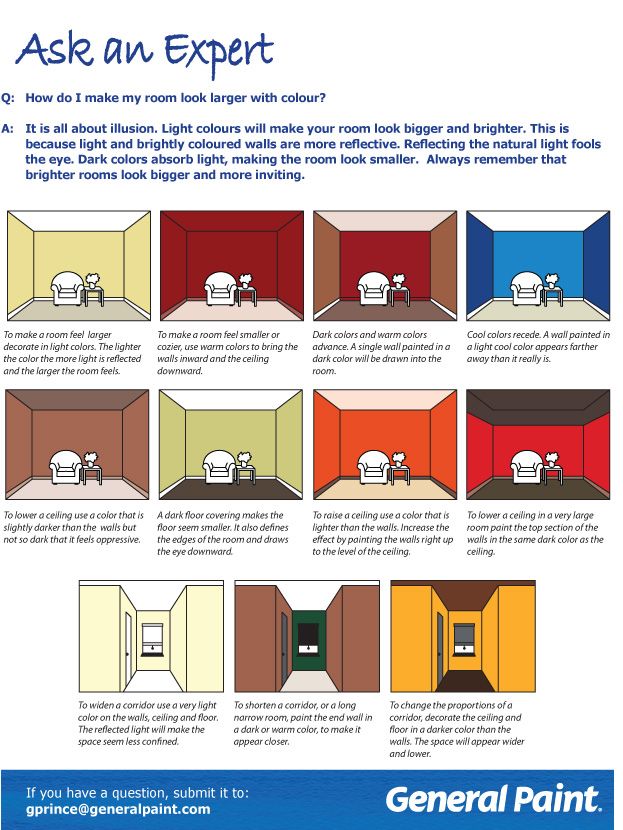 Such buildings can occupy the entire wall or the space around the window (which is usually not used anyway). nine0003
Such buildings can occupy the entire wall or the space around the window (which is usually not used anyway). nine0003
It is better to store clothes in closed furniture, especially with light facades. Such cabinets should be installed up to the ceiling in order to make the most of the available space. A good alternative to built-in wardrobes is to attach a long stylish curtain to the ceiling on the eaves. Such a mini dressing room can occupy the entire wall. Behind the curtain, you can install hangers, crossbars and shelves. They can also fit in baskets or organizers.
A smart solution in a small room is to use multifunctional furniture, such as sofas with shelves on the sides, large ottomans with opening lids, coffee tables with storage compartments or nooks with drawers. nine0003
How color changes the perception of interior space in an interior atmosphere, emotional and psychological comfort, fill with a sense of spaciousness and freshness. Big influence the composition of the interior is influenced by the choice of a color palette that can not only create an emotional mood, but also visually change the proportions of space.
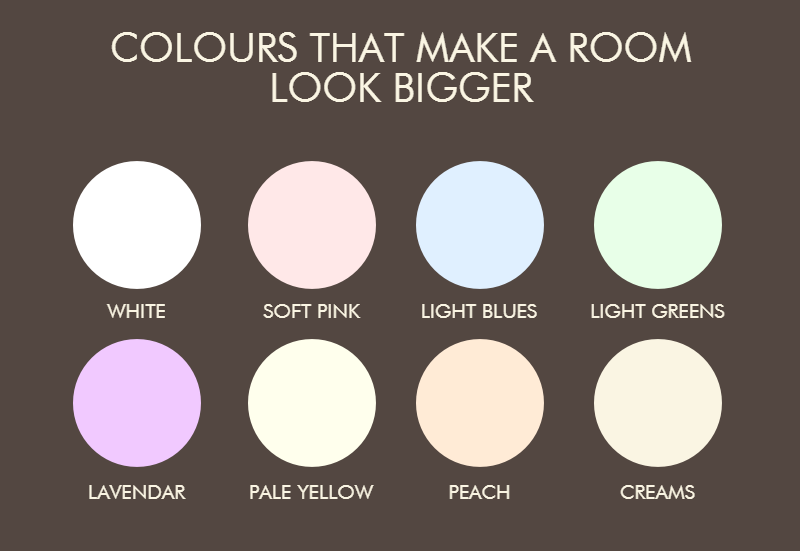
Skillfully placing color accents and choosing the necessary color scheme, you can create the illusion of a large rooms within a small space and, conversely, reduce the size of the volume, as well as make the room higher, longer or wider, raise or lower the ceiling, draw attention to a particular wall. nine0003
Skillfully placing color accents and choosing the necessary color scheme, you can create the illusion of a large rooms within a small space and, conversely, reduce the size of the volume perceived premises, change its proportions, hide flaws, shift accents. Therefore there will be no it is an exaggeration to say that color is the main tool in the visual change of space. nine0003
The classic use of the palette in the interior: several primary colors and one for accent
How color works
There are a lot of colors and their combinations. First of all, they are divided into main, basic and complex. Main the colors, or primary, are red, yellow, and blue. It is with the help of their mixing that a great many colors and shades, which are called secondary. Primary colors are orange, green, purple, red, yellow, blue. All other colors obtained through combinations are called intricate colors. nine0003
It is with the help of their mixing that a great many colors and shades, which are called secondary. Primary colors are orange, green, purple, red, yellow, blue. All other colors obtained through combinations are called intricate colors. nine0003
In addition, the colors are divided into warm, cold and neutral, as well as light, medium and heavy. So, the whole blue range is cold, and the green range is neutral. The color palette from yellow to red is considered warm. Light colors are cold, low-saturated and light tones, such as the color of the blue sky. Heavy colors are considered to be dark, dense colors, including olive and brown.
A room made in warm colors
How can colors and their combinations with each other affect the perception of space? For example, light and cold colors, as well as light and low-saturated tones visually make the space larger. But warm colors, and these are yellow, orange and red, create the opposite effect. Darker, heavier and denser colors can also optically reduce the volume of a room. nine0003
nine0003
A room made in cold colors
In addition to information about the influence of a particular color on the perception of space, you need to know their location inside the room visually changes its volume, makes the room larger, higher, longer, wider.
Let's look at examples of how you can visually change the proportions of the interior using color. space.
Palette of primary colors and their combinations
How to increase space
A classic method of visually increasing the space is a combination of a dark floor, light walls and light ceiling. Given that the ceilings in typical apartments are low, on average they reach 2.5-2.8 meters, they have to be made light so that there is no feeling of pressure.
An example of an interior with a technique for increasing space with a dark floor and light walls
Dark floor, light walls and ceiling visually increase the space
How to make a room wider
The room will visually become wider if you use a combination of a dark floor with a dark ceiling and light walls. This will visually expand the room, but also reduce its height. The easiest way is to decorate the ceiling and walls with one material. You can simply paste over the walls and ceiling with the same wallpaper, paint it with the same paint.
This will visually expand the room, but also reduce its height. The easiest way is to decorate the ceiling and walls with one material. You can simply paste over the walls and ceiling with the same wallpaper, paint it with the same paint.
And if this is a country house, then you can use dark wood for flooring and ceiling, and light lining for walls. A narrow long room, for example, a corridor, can be visually expanded by applying the following color scheme: paint the side walls with a cold light color, and the far wall with a warm one. nine0003
Contrasting ceiling has a special effect
Dark floors, ceilings and light walls visually expand the space.
How to "raise" the ceiling and make the room "deep"
In this case, the ceiling and floor should be light, and the walls to the right and left of the entrance should be dark. The wall opposite from the entrance is made light. Thus, it seems to move deeper, while the ceiling seems higher.
Light floor, ceiling and back wall - this combination will help visually make the room narrower, but deeper and higher. The ceiling can be painted with white paint or a color a tone lighter than the walls. It should be remembered that cold tones, and these are shades of gray, blue, green, visually move away, thus they can make the ceiling higher. nine0003
The effect can be enhanced by wallpapering the walls with vertical stripes, thus lengthening the wall and making the ceiling appear higher.
A cozy and "deep" room, visually emphasized with dark walls and a contrasting floor
How to "lower" the ceiling and "push" the walls
Sometimes lowering the height of the ceiling can make a space more comfortable and cozy. Painted a darker color than the walls, the ceiling appears lower. The combination of a dark floor with a dark ceiling visually expands the room, reducing its height. nine0003
How to make the room shorter and bring the back wall closer
Combining a dark back wall with light side walls makes the space appear shorter. The back wall is optically closer, making the room appear shorter. And to make the side walls shorter, go with a darker shade towards the bottom of the wall.
The back wall is optically closer, making the room appear shorter. And to make the side walls shorter, go with a darker shade towards the bottom of the wall.
An example of such a method in a project from the TB.Design studio
How to make a room smaller
You can make a room smaller by using dark walls. You can decorate the walls around the entire perimeter with dark wallpaper, paint or panels, while making the floor dark and the ceiling light. A light ceiling against a dark floor and walls creates the effect of a basement or well, since the light spot is only at the top. This technique is often used to decorate a study, bedroom or living room. Box rooms are preferred by English and French designers, who believe that such an environment creates a special chamber effect. nine0003
To make the room more compact, small and cozy, you can use bright colors on the walls, which will absorb most of the natural light and create a feeling of isolation.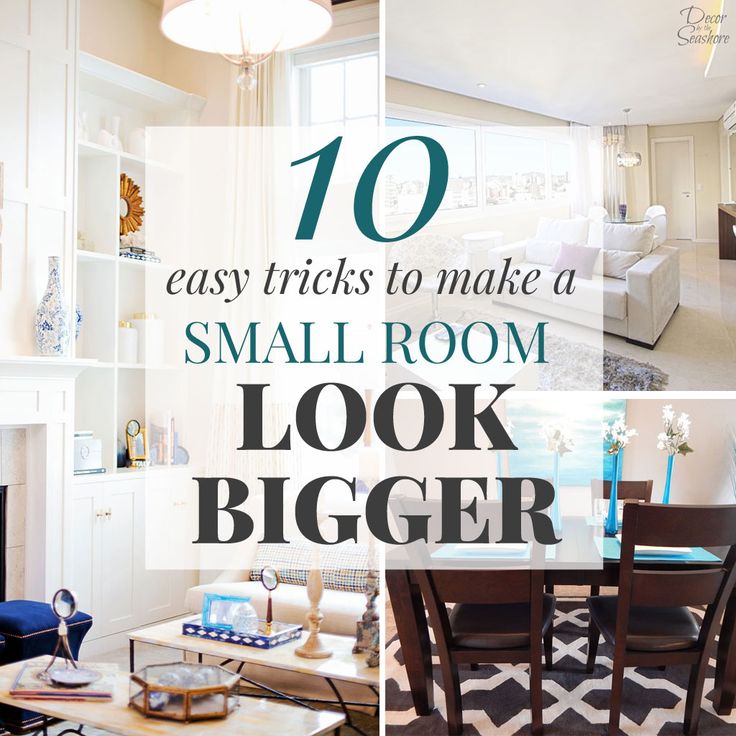
This approach can often be found in classic interiors.
How to make a room longer
To visually lengthen a room, it is necessary to lighten the far wall. Light back wall, ceiling and floor visually make the room narrow, high and deep. In this case, there is no need for contrasting finishing materials. In the role of a light wall, for example, the facade of built-in furniture can act. nine0003
How to make a room narrower and longer
The side walls should be light, they lower the room, make it visually narrow. Due to the dark floor and ceiling, the room becomes elongated in length. This option is not suitable for everyone, because not everyone likes a crushing dark ceiling. The proportions of the room in this case are balanced thanks to two light walls.
How to emphasize the horizontal lines
This technique is recommended to be used in rooms with irregular ceiling geometry, which include, for example, attics and attic rooms. You can align the lines horizontally with a more saturated shade of the walls. The combination of dark walls with a light floor and ceiling will cope with this task. A square room made in this version will immediately seem elongated. nine0003
You can align the lines horizontally with a more saturated shade of the walls. The combination of dark walls with a light floor and ceiling will cope with this task. A square room made in this version will immediately seem elongated. nine0003
Light at the end of the tunnel
If space is completely dark, it will lose its shape. Usually this problem concerns long walk-through halls and corridors. In order to enliven the space and give it a more attractive look, you can create a “light at the end of the tunnel” effect. In this case, you should make a choice in the direction of a lighter back wall, where the human eye will be drawn. And the ceiling and darker side walls will form the visual effect of the tunnel.
How to create a feeling of spaciousness
A room with white walls, white ceiling and floor certainly looks very spacious. However, at the same time, it has a very cold interior, and this is not always comfortable. You can dilute it with bright color spots, using warm, light shades or dark furniture for this.